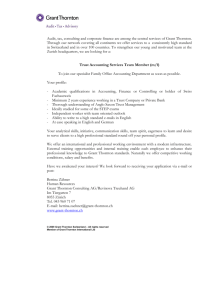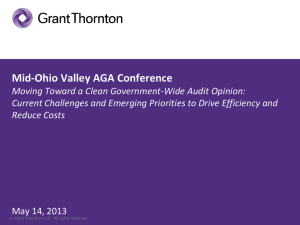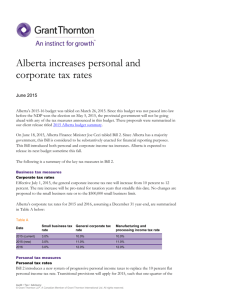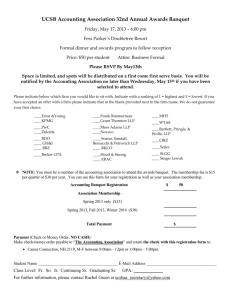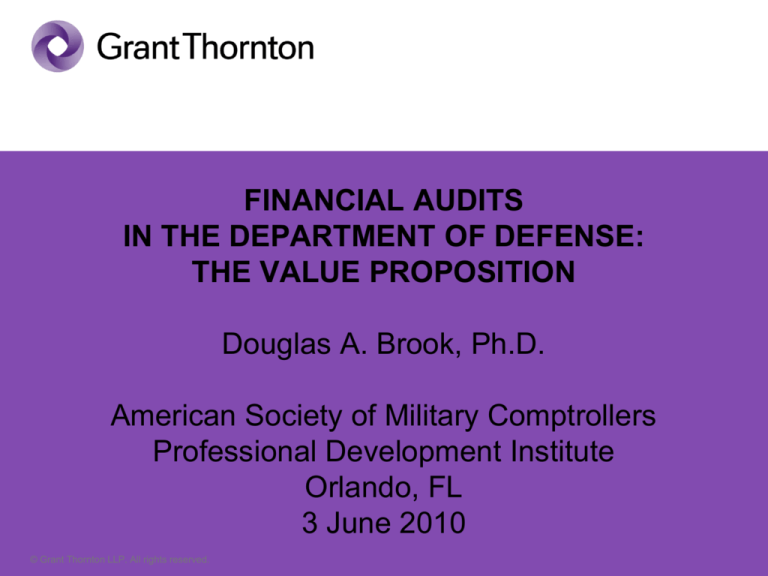
FINANCIAL AUDITS
IN THE DEPARTMENT OF DEFENSE:
THE VALUE PROPOSITION
Douglas A. Brook, Ph.D.
American Society of Military Comptrollers
Professional Development Institute
Orlando, FL
3 June 2010
© Grant Thornton LLP. All rights reserved.
RESEARCH QUESTIONS
• What is the value of financial audits to DoD?
• How can financial audits best serve DoD financial
and non-financial managers, leaders and decisionmakers?
• What are the possible next steps in the evolution of
financial audits in DoD even as DoD pursues audit
readiness and eventual unqualified opinions?
© Grant Thornton LLP. All rights reserved.
2
CFO ACT
20TH ANNIVERSARY
CFO Act of 1990
Pilot project included Departments of Army and Air Force
1994 Government Management Reform Act
Expanded CFO Act financial statements to all government
departments and agencies, including DoD and all Service
Components and mandated consolidated audited financial
statement
2002 Accountability of Tax Dollars Act
Expanded CFO Act requirements to all agencies with BA >$25
million
2004 OMB Circular A-136
Performance and Accountability Reports for GPRA and CFO Act.
© Grant Thornton LLP. All rights reserved.
3
MY RECORD
FY 1991 Department of the Army Consolidated Financial Statement –
disclaimed
FY 2007 and 2008 Department of the Navy Financial Statements –
disclaimed
“The Assistant Secretary of the Navy (Financial Management and Comptroller)
acknowledged to us that the Department of the Navy General Fund FY 2008 and FY 2007
Financial Statements would not substantially conform to accounting principles (GAAP)
and that DoD financial management and feeder systems were unable to adequately
support material amounts on the financial statements as of September 30, 2008.”
FY 2007 and 2008 Department of Defense Financial Statement -disclaimed
“The Acting Under Secretary of Defense (Comptroller)/DoD Chief Financial Officer
acknowledged to us that the DoD agency-Wide FY 2008 and FY 2007 Financial
Statements would not substantially conform to accounting principles (GAAP) and that
DoD financial management and feeder systems were unable to adequately support
material amounts on the financial statements as of September 30, 2008.”
© Grant Thornton LLP. All rights reserved.
4
METHODOLOGY
1.
Review of scholarly and practitioner literature and reports from GAO and
other government sources.
2.
Examination of uses and users of financial audits in the private sector for
comparability
3.
Two roundtable discussions
–
–
–
Representatives from the offices of DoD and service component deputy
chief management officers and deputy chief financial officers
Non-DoD CFOs and DCFOs
Grant-Thornton executives with prior experience as government financial
officials
4.
Telephone and e-mail interviews with DoD financial management officials
5.
Today, we are asking you to participate in a short survey on issues about
audited financial statements.
[1]
[1]
© Grant Thornton LLP. All rights reserved.
5
TYPES OF ACCOUNTING IN DoD
Financial Accounting: The focus is on the accurate and reliable
capturing, recording, categorizing, and presenting of historical events.
Managerial Accounting: The focus is on information for internal
management decisions about the organization’s mission and scope of
operations […].
Budgetary Accounting: Most familiar in government. The process of
budgeting, justifying, and accounting for appropriations […].[i]
[i] Candreva, P.J., “Accounting for Transformation.” Armed Forces Comptroller 49 (4), (Washington: American Society of Military Comptrollers, 2004): 7-13.
© Grant Thornton LLP. All rights reserved.
6
AUDITS:
DEFINITION
“Auditing is a systematic process of objectively obtaining and evaluating
evidence regarding assertions about economic actions and events to
ascertain the degree of correspondence between those assertions and
established criteria and communicating the results to interested users.”
“Auditing is … an assurance service that objectively gathers evidence
and communicates to third parties.”
Rittengerg, L. E. & Schweiger, B. J. (2005). Auditing: Concepts for a Changing Environment. 5th Edition. Mason, OH: Thomson Southwestern,
.
4
© Grant Thornton LLP. All rights reserved.
7
AUDITS:
PURPOSE
The purpose of audits is to
“reduce information risk.”
Ricchiute, D. N. (2006). Auditing. 8th Edition. Mason, OH: Thomson Southwestern, 2.
© Grant Thornton LLP. All rights reserved.
8
VALUE PROPOSITION #1
Financial
audits
serve
to
improve
stewardship
and
accountability
and
perceptions about the quality of agency
financial management.
© Grant Thornton LLP. All rights reserved.
9
POSITIVE FINDINGS:
VALUE PROPOSITION #1
DCAA: “a positive and significant impact attaining
and maintaining the public’s trust and confidence.”
GAO survey: “Substantial benefits including
enhanced accountability and enhanced public
perceptions.”]
[i]
U.S. Government Accountability Office, Financial Management: Extending the Financial Statement Audit Requirement of the CFO Act to
Additional Federal Agencies, (Washington, DC: GAO, May 14, 2002).
AGA survey: “Higher level of accountability”
Association of Government Accountants, Scoring Financial Management & Oversight Efforts. (Washington DC: Grant Thornton, LLP,
2007): 8.
© Grant Thornton LLP. All rights reserved.
10
VALUE PROPOSITION #2
Financial audits drive improvements in
financial management systems, policies and
processes to produce more accurate and
timely financial information.
© Grant Thornton LLP. All rights reserved.
11
POSITIVE FINDINGS:
VALUE PROPOSITION #2
DCAA: “improved internal control and reduced material
weaknesses, reduced errors and improved data integrity,
documentation reliability.”
GAO survey: Substantial benefits including: identifying
inefficiencies and weaknesses, improved internal control,
and monitoring assets and liabilities.]
U.S. Government Accountability Office, Financial Management: Extending the Financial Statement Audit Requirement of the CFO Act to Additional Federal Agencies,
(Washington, DC: GAO, May 14, 2002).
AGA survey: [Audits that] “require closing books,
reconciling accounts, tracking assets, valuing inventories
and receivables, recognizing long-term liabilities ... bring a
discipline that enables a more effective use of resources.”]
[i]
Association of Government Accountants, Scoring Financial Management & Oversight Efforts. (Washington DC: Grant Thornton, LLP, 2007): 8.
© Grant Thornton LLP. All rights reserved.
12
VALUE PROPOSITION #3
Audited
financial
statements
provide
information for use by internal and external
policy-makers, decision-makers, leaders and
managers.
© Grant Thornton LLP. All rights reserved.
13
MOSTLY NEGATIVE FINDINGS:
VALUE PROPOSITION #3
“Financial statements are only important to the
CFO and do not register high [with] the agency
administrator or Congress .... Financial statements
... are ... not used to manage programs or make
key decisions.”]
[i]
Association of Government Accountants, Scoring Financial Management and Oversight Efforts, (Washington, DC: Grant Thornton,
LLP, 2007): 12.
© Grant Thornton LLP. All rights reserved.
14
TESTING THE
PRIVATE SECTOR ANALOGY
Who uses audited financial information?
What are the uses of audited financial information?
What are the main analytical tools employed to
understand audited financial statements?
Is any of this applicable for DoD?
© Grant Thornton LLP. All rights reserved.
15
ACCOUNTING EQUATIONS
Corporate:
Assets = Liabilities + Shareholder Equity
Federal Government:
Assets = Liabilities + Net Position
© Grant Thornton LLP. All rights reserved.
16
CORPORATE FINANCIAL
STATEMENTS
Balance Sheet – a snapshot of the enterprise’s assets and
liabilities and shareholder equity at the end of the reporting
period. It depicts a firm’s resources and the claims on those
resources
Income Statement – measures operating performance,
showing revenues, expenditures and net income (or loss)
over the reporting period.
Statement of Cash Flow – describing net cash inflows
(inflows minus outflows) for operating, investing and
financing activities.
[i]
Clyde P. Stickney, “Financial Statement Analysis,” Security Analysis and Pricing, B3-1-B3-31.
© Grant Thornton LLP. All rights reserved.
17
USES AND USERS OF CORPORATE
FINANCIAL STATEMENTS
Investment decisions
Existing and potential investors and lenders, analysts, rating agencies
Make decisions about financial participation
Business decisions:
Existing and potential suppliers, customers, venture partners, competitors, and
labor unions
Assess the risks, identify opportunities, benchmark their own performance.
Evaluate management:
Boards of directors, investors, and management
Compare performance with peers.
Manage financial issues:
Boards of directors and management
Identify issues of risk and opportunities
Identify policy issues:
Policy analysts and advocates, politicians, media
Data and information
© Grant Thornton LLP. All rights reserved.
18
DoD FINANCIAL STATEMENTS ARE
SIMILIAR AND DIFFERENT
Balance Sheet – a snapshot of the department’s financial position at the
end of the fiscal year, depicting assets, liabilities and net position.
Statement of Net Cost – depicting the gross costs of operations for the
period minus any exchange revenues earned from its activities.
Statement of Changes in Net Position – the sum of operations since
inception plus unexpended appropriations at the end of the period.
Statement of Budgetary Resources – reports the use and availability of
budgetary resources at the end of the period.[
i]
U.S. Department of Defense, Agency Financial Report for FY 2009, Addendum A: 12.
© Grant Thornton LLP. All rights reserved.
19
ARE THERE REALLY COMPARABLE USERS AND USES
OF DoD AUDITED FINANCIAL STATEMENTS?
Investment Decisions:
Is it really possible to think that Congress, the Office of Management
and Budget, or taxpayers at large could make use of financial
statements to make decisions about putting investments in DoD?
Assessment Decisions:
Could Congress, OMB and agency leaders really assess the
performance of DoD programs and management using audited
financial reports?
Identifying Financial Issues:
Can Congress, OMB and agency leaders use financial statements
to identify financial issues?
Policy Issues:
Can external users such as media, interest groups, policy advocates
and internal policy makers in the agency and elsewhere in the
government use DoD financial reports to identify policy issues?
© Grant Thornton LLP. All rights reserved.
20
EXAMPLE: RATIO ANALYSIS
•
•
•
•
•
•
•
•
•
•
•
•
•
•
•
•
•
•
•
•
•
Liquidity
Short Run Liquidity
Current ratio
Quick ratio
Cash flow liquidity ratio
•
•
•
•
•
•
Profitability
Margins
Gross profit margin
Operating profit margin
Net profit margin
Cash flow margin
Leverage (Financial Leverage Index)
Amount of Debt
Debt/assets
Debt/equity
Long-term debt/total capitalization
Operating Efficiency
Asset Management
Accounts receivable turnover
Inventory turnover
Accounts payable turnover
Fixed asset turnover
Total asset turnover
Return on total assets
© Grant Thornton LLP. All rights reserved.
Liquidity of Current Assets
Average collection period
Days inventory held
Days payable outstanding
Cash conversion cycle
Coverage of Debt
Times interest earned
Cash interest coverage
Fixed charge coverage
Cash flow adequacy
Market Measures
Earnings per share
Price/earnings
Dividend payout
Dividend yield
Returns
Return on total assets
Return on equity
Cash return on assets
21
RATIO ANALYSIS:
LIMITED USE FOR DoD
Current ratio: (current assets/current liabilities) measures short term
liquidity by assessing the ability of the organization to meet demands
for cash as they arise.
Debt ratio: (total liabilities/total assets) indicates the ability of the
organization to meet its liabilities with assets, and measures the
proportion of assets financed by debt.
Debt to equity (total liabilities/stockholders equity or total liabilities/net
position) measures liabilities against the equity base.
Using data in the FY 2008 DoD financial statements we calculate:
•
Current ratio:
~$480b/$35b = 13.7
•
Debt ratio:
~$2.2t/$1.6t = 1.375
•
Debt to equity:
~$2.2t/-$.476t = -5.8
© Grant Thornton LLP. All rights reserved.
22
CORPORATE ANALOGIES:
ASKING THE WRONG QUESTION?
Government financial statements have limited
external uses or users. “Who uses the financial
statements to decide whether to buy Treasury
bonds?”
Claiming usefulness is “justifying audited financial
reporting for all the wrong reasons.”
Grant-Thornton Roundtable on Audited Financial Statements, Washington, DC, May 6, 2010.
“The Harvard Business Review should have a
skull and cross bones stamped on the cover with
the warning ‘not to be taken by the public sector’.”
Henry Mintzberg, Academy of Management, 1995.
© Grant Thornton LLP. All rights reserved.
23
VALUE PROPOSITION #3
REVISED
Financial audits reduce information risk and
provide assurance about the reliability of
financial information used by internal and
external policy-makers, decision-makers,
leaders and managers.
“If you can’t trust the data, how can you rely on the analysis?”
[i] Grant-Thornton Roundtable on Audited Financial Statements, Washington, DC, May 6, 2010.
© Grant Thornton LLP. All rights reserved.
24
RETURNS ON INVESTMENT
IN FINANCIAL AUDITS
Validation of Financial Audits:
The requirement for financial audits
continues to have validity
“…we have to accept some hard fiscal realities.
American taxpayers and the Congress are
rightfully worried about the deficit. At the same
time, the Department of Defense’s track record as
a steward of taxpayer dollars leaves much to be
desired.”
Gates, Robert, Secretary of Defense, speech at Navy League Sea-Air-Space Expo, National Harbor, MD, May 3, 2010 .
© Grant Thornton LLP. All rights reserved.
25
RETURNS ON INVESTMENT
IN FINANCIAL AUDITS
Audits as a Forcing Function:
The requirement for audits drives
financial management improvements
that would otherwise take longer or not
occur at all.
© Grant Thornton LLP. All rights reserved.
26
RETURNS ON INVESTMENT
IN FINANCIAL AUDITS
Audits Support Financial Management Efficiencies:
Within the financial management
domain, audits can have positive costbenefit ratios based on savings
generated from improved financial
operations.
© Grant Thornton LLP. All rights reserved.
27
RETURNS ON INVESTMENT
IN FINANCIAL AUDITS
Financial Audits as a Response to Criticism:
Financial audits, with their implications
for the quality of internal controls and
financial
management
information
systems can play an important role in
the Department’s response to criticism.
© Grant Thornton LLP. All rights reserved.
28
RETURNS ON INVESTMENT
IN FINANCIAL AUDITS
Financial audits are not program audits:
Considerations
of
“materiality”
and
“reasonable assurance” provide a different
viewpoint
of
compliance,
risk
and
performance that support management
decisions about investment priorities, and for
controlling,
justifying
and
allocating
resources.
Knubel, John, “Thoughts and Observations Regarding the Current Proven and Future Value of the CFO Act Financial Auditing Process to the
© Grant
Thornton LLP.
All rights
Department
of the
Navyreserved.
and DoD’s Warfighting Mission,” unpublished paper, April 30, 2010, p. 2.
29
THE DoD AUDIT CHALLENGE
Reach audit readiness and achieve and sustain
unqualified audit opinions … while demonstrating
value from financial audits.
© Grant Thornton LLP. All rights reserved.
30
AUDITED FINANCIAL INFORMATION
AND DoD’s BUDGET CHALLENGE
Secretary Gates: “…as the Defense Department begins the process of
preparing next year’s Fiscal Year 2012 budget request …The goal is to
cut our overhead costs and to transfer those savings to force structure
and modernization within the programmed budget. In other words, to
convert sufficient “tail” to “tooth” to provide the equivalent of roughly two
to three percent real growth …. Simply taking a few percent off the top
of everything on a one-time basis will not do.
In this environment, reliable and timely audited
financial information becomes more important to
leaders and managers. Even as the costs associated
with audits will be scrutinized.
© Grant Thornton LLP. All rights reserved.
[i
31
REVISED FIAR PLAN: MOVING IN
THE RIGHT DIRECTION
Goals:
– Achieve and sustain audit readiness by FY 2017
– Implement business or financial systems that resolve material
weaknesses
– Ensure effective internal controls are in place
Process:
Focusing on priority information that will better serve the warfighter and
DoD decision makers.
– (1) budgetary information – status of funds received, obligated and
expended – leading to auditability for the Statement of Budgetary
Resources (SBR); and
– (2) mission-critical asset information – military equipment, real
property, inventory, operating material and supplies, and general
equipment – leading to a management assertion on existence and
completeness (E&C).
[i]
© Grant Thornton LLP. All rights reserved.
32
LOOKING TOWARD THE FUTURE
AUDIT REFORM PROPOSALS
Reduced the costs and burdens of compliance.
Develop special purpose reports for targeted users
Change accounting and audit standards to make
them more governmental and tailor audit practices
and opinions to the revised standards. [i
© Grant Thornton LLP. All rights reserved.
33
RECOMMENDATIONS
DoD should continue its commitment to achieving audit
readiness and unqualified audit opinions.
DoD’s financial managers should proactively demonstrate
the return on investments in financial audits
DoD financial managers should concentrate on extracting
audited financial data and making it available to nonfinancial managers to help in making key budget,
management and policy decisions.
Attention should be given by OMB, Congress and the audit
community to reform proposals that reduce the costs and
administrative burdens of CFO Act compliance, make
information more relevant to users, and conform audit
standards and processes more to the governmental sector.
© Grant Thornton LLP. All rights reserved.
34
Grant Thornton Contacts
Lou Crenshaw VADM USN (Ret)
Vice President
T 703. 637.4430
E Lou.Crenshaw@gt.com
Doug Brook Ph.D.
Consultant
T 831.373.4975
E dougbrook@hotmail.com
Thad Juszczak
Director
T 703.637.3079
E Thad.Juszczak@gt.com
Lisa Fiely
Director
T 703.373.8720
E Lisa.Fiely@gt.com
© Grant Thornton LLP. All rights reserved.
Global Public Sector
333 John Carlyle Street
Suite 400
Alexandria, Virginia 22314
703.837.4400
35


